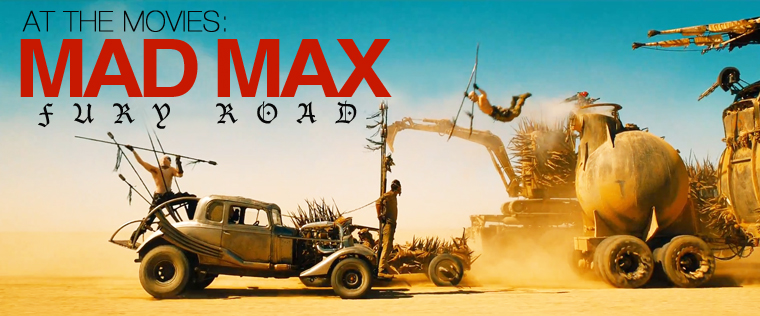Hope Runs Mad
by Andrew Collins
Mad Max: Fury Road is this year’s Edge of Tomorrow – the truly unique action film that dared to break the cycle of superhero and shoot-em-up flicks – except that it’s actually a really good movie.
In both aesthetic and action it hits that wicked-sick, over-the-top sweet spot, taking us on a demon-possessed ride down a trail of fury.
In this raging apocalyptic tale, the world runs on a currency of gasoline and bullets, the highest descriptor of praise is “chrome,” and colorful personalities rule the Australian wasteland with monikers like Max Rockatansky, Imperator Furiosa, Rictus Erectus, and Immortan Joe. Mankind has reverted to a grease-monkey tribalism where heaven is an eternal road of shiny hotrods achieved by means of glorious sacrifice in the service of the chieftain. Warlords rove the Australian wastelands in Reaver-like highway gangs with all the braggadocio of a flame-spewing double-necked guitar shredder on a truck overloaded with amps and subwoofers (which is a lot).
In other words, the film truly befits its title. The series has come a long way from when director George Miller had Mel Gibson peeling out in the Outback. But Miller clearly had a vision for Mad Max, and this time he spared no detail in bringing it to fruition.
Blazing across the sands of Namibia (where the film was shot), Fury Road boasts nearly twice as many cuts as The Road Warrior, an earlier installment in the series, and it stands on its own enough for the post-80s generation to enjoy without having seen the original films.
The opening scene introduces this world with a shaggy-haired Max (Tom Hardy) standing on a plateau next to his armored roadster. He muses on the hellish, maddening world he’s living in, haunted by both the living that prey on each other and the fallen loved ones that he could not save. A two-headed lizard scampers up to him. He crushes it beneath his heel, picks it up, and eats it. “My world is reduced to a single instinct,” he says: “survival.” This is the maddening to which the film’s title refers. Humanity has lost the abundance of resources that makes peace possible in an imperfect world. They are alienated from the hostile nuclear wasteland and from each other – tormented on all sides.
The conflict revolves around a flight for freedom by five nymphic young women – the harem of ghoulish baddie Immortan Joe (Hugh Keays-Byrne) – under the care of Imperator Furiosa (Charlize Theron). There’s something kind of ridiculous about these veritable goddesses existing in a world where everyone else is lucky to still have all their teeth (if not all their limbs). And yet within the Fury Road universe, even sex appeal has been curbed by the survival instinct. In a nice twist on the genre, the wives turn out to be some of the most sophisticated characters in Fury Road. Only their courage to flee the oppression of Immortan Joe and claim their own humanity makes the story possible.
“It had no plot. It was like all action.” I overheard one viewer say in that perennial philistine critique of attempted sophistication. If there is any major criticism of the film, it is this, but it is an oversimplification. In terms of character development and story, Fury Road shows how less can be more. You could fit all of Max’s lines on a napkin, but his truncated dialogue imbues the film with substance. He doesn’t waste words; each one drops heavily from a profoundly troubled mind. “As the world fell each of us in our own way was broken,” Max says in his opening narration. The horrors of the apocalypse have stripped away all masks of pretension, and so in Fury Road we find human nature stripped down to its bare-boned fundamentals.
For Max, it is escape from the deep, haunting guilt that comes from a failure to save loved ones. “You know hope is a mistake,” he tells Furiosa before their last-ditch gambit. “If you can’t fix what’s broken, you’ll go insane.” For Immortan Joe, it is the classic villain’s god-complex and the desire to pass on his legacy through a son (carried by one of his fleeing wives). For Nux (Nicholas Hoult), an indoctrinated “war boy” minion for Immortan Joe who ends up joining the side of Joe’s fleeing wives, it is purpose and salvation through glorious deeds. “I live; I die; I live again,” he cries in the first chase sequence. For Furiosa, the protector and rogue warrior who seeks to shuttle the women away to the “green place” where she was born, it is redemption. For the women themselves, it is freedom from slavery – basic human dignity. “We are not things,” they repeat to themselves as mantra, “We are not things!”
At the root of everyone’s reckless abandon is the hope for a better life – a return to the Eden of the civilized world. “It feels like hope,” says Nux as the film ramps up for the final conflict, and we feel it too. When the world is teetering on the brink madness, there’s no other choice: fix what’s broken, or go insane.








